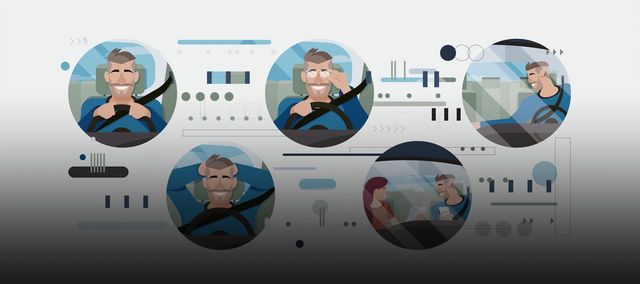24 January 2019
The race to come up with the world’s first self-driving car is in full swing. Google, Uber, Tesla and various international carmakers and suppliers such as Bosch and ZF all have the same goal in mind: They all want to be the first to reach level 5, the highest level of autonomous driving. So what exactly is meant by these levels, as defined, for instance, by the German association for the automobile industry, the VDA? And at what level are today's production cars? Read this post to find out.
Level 1: Assisted driving
Drivers are in control of their vehicle at all times.
© James Boast
- Drivers must keep a continuous eye on the traffic.
- Drivers are liable for damage and traffic violations.
- Individual assistance systems provide support for certain driving tasks.
In many cars, assisted driving is already a reality: cruise control maintains the desired speed; adaptive cruise control keeps the vehicle at a safe distance from the car in front; and automatic lane-departure warning systems stop the vehicle from wandering off course on motorway journeys.
Level 2: Semi-autonomous driving
Drivers are in control of their vehicle at all times.
- Drivers must keep a continuous eye on the traffic.
- Drivers are liable for damage and traffic violations.
- The vehicle stays in lane, slows down and accelerates autonomously under certain defined conditions.
© James Boast
With semi-autonomous driving, the car can temporarily perform some tasks without human intervention. A level-2 vehicle can, for instance, stay in lane on the motorway while simultaneously braking or accelerating. To this end, various individual systems are paired, such as, for example, the adaptive cruise control and the lane-departure and emergency braking assistants. “This pairing is what makes this so different from assisted Level-1 driving,” explains Katrin Leicht, an expert on autonomous driving at TÜV NORD. Level 2 also includes an overtaking assistant or a parking assistant to manoeuvre the vehicle autonomously into a parking space.
When the car is in semi-autonomous mode, the driver may take their hands off the steering wheel for a short time. But they need to keep an eye on the traffic and the assistance systems and take full responsibility at all times.
Level 3: Highly autonomous driving
Driver may temporarily take their attention off driving and the traffic.
© James Boast
- The car drives independently in predefined situations.
- Drivers must be ready to take control again at a moment’s notice when requested to do so by the system.
- Drivers are liable only if they fail to comply with this request.
A Level-3 car can handle certain driving tasks autonomously and without human intervention. But only under certain conditions as previously defined by the manufacturer - for example, in traffic jams or motorway driving. The expectation is that these will be the first situations to witness the deployment of highly autonomous cars. After all, motorway driving involves neither oncoming traffic nor complex junction situations in which other road users, such as cyclists or pedestrians, also play a part. Moreover, the lane markings are generally in good repair and the roads consistently digitally mapped.
During Level-3 drives, the 2017 amendment to the German Road Traffic Act says that drivers “may temporarily turn their attention away from the traffic and management of the vehicle” but must at the same time “remain sufficiently aware” as to ensure that they can take back control within a certain time window if the systems sends a signal requiring them to do so. A black box records the details of the autonomous driving. This makes it possible to reconstruct a situation to establish, for instance, whether a speeding offence or an accident was the fault of the system or the driver. The latter will be liable only if they were in control of the vehicle at that moment or failed to respond to the system’s request in time.
Just how much time the driver should have to reassume control of the vehicle is yet to be determined by law. Also yet to be determined are the activities that will be permitted during highly automated drives - whether the driver will be allowed to read the paper or surf the Net on a smart phone or merely to drink coffee and turn around once in a while to check on the children, as expert Leicht from TÜV NORD explains.
Level 4: Fully autonomous driving
Drivers can surrender control over longer distances and in different traffic situations.
- The vehicle can manage drives on certain routes (such as motorways) completely autonomously.
- The system can recognise its limitations in time to return to a safe state in compliance with the regulations.
- Drivers must nevertheless always be fit to drive and able to take the wheel in an emergency or in certain driving situations.
- Drivers are not liable for traffic infringements or damage for the entire duration of a fully autonomous drive.
© James Boast
At Level 4, a car is able to cope with different traffic situations and cover long distances without human intervention. “The system is less limited than at Level 3,” explains Katrin Leicht. It would, for example, allow the car to join the motorway and manage the entire journey independently. Such a vehicle would not only have all the sensor technology it would need to keep a comprehensive overview of the various roads and traffic situations; it would also be able to talk to the infrastructure and other vehicles.
The intention is for the systems to identify their limits reliably and promptly so that they either give the driver sufficient warning to reassume control of the vehicle or bring the vehicle back into a “safe state” - for instance by initiating an emergency stop by the roadside. “But seeing as this won’t be possible on all roads or in all traffic situations, drivers will continue to be the backstop and will have to be ready and able to take the wheel again should conditions demand it,” Leicht adds. Which is why they should always be fit to drive and not be permitted to take the wheel having downed a couple of glasses of red.
There currently isn’t, however, any legal framework for fully autonomous vehicles. In other words, drivers have no binding rights or obligations in this operating mode. For instance, it hasn’t yet been determined whether drivers can sit back and relax for the duration of a fully automated journey or even take a nap if they know that they will be spending the next four hours on the motorway. And this isn’t the sole challenge: The more frequently and the longer the vehicle does the driving, the less habituated drivers will be to a routine. At the same time, they need to be able to switch at a moment’s notice from relaxation to concentration, to steer the vehicle through dangerous situations. “This is why it might make sense to make Level-4 drivers undergo special training, like pilots.” says Katrin Leicht by way of recommendation.
Level 5: Autonomous driving
There are only passengers without any driving tasks.
- The tech in the car handles all the traffic situations.
- Journeys without passengers are possible.
- Passengers are not liable for traffic infringements or damage for the entire duration of the drive.
© James Boast
At Level 5, the steering wheel and accelerator pedal will disappear, and drivers will become full-time passengers. A driver's licence will no longer be required, and it will be possible to use the vehicle even after the Christmas party. In the event of an accident, the manufacturer or the operator of an autonomous taxi will be liable accordingly.
“When it comes to the law, the Vienna Convention on Road Traffic will need to be amended, as driverless car travel is currently prohibited,” explains Katrin Leicht from TÜV NORD. Generally speaking, there is still no legal framework for autonomous vehicles. There is still a complete lack of clarity concerning the rights and obligations of the manufacturers or operators of such cars and their driving systems, and the same applies to the question of insurance.
You may also like
ABOUT
Katrin Leicht is a mechanical engineer and type tester for driver assistance systems at TÜV NORD’s Institute for Vehicle Technology and Mobility (IFM). Her work there involves autonomous and networked driving, and she is working with her colleagues to come up with solutions to ensure that such systems can be safely unleashed on public roads.








